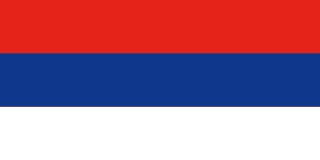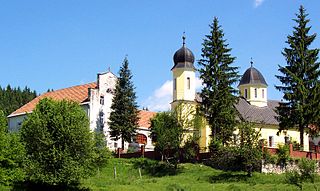
Aloysius Viktor Cardinal Stepinac was a senior-ranking Yugoslav Croat prelate of the Catholic Church. A cardinal, Stepinac served as Archbishop of Zagreb from 1937 until his death, a period which included the fascist rule of the Ustaše over the Axis puppet state the Independent State of Croatia from 1941 to 1945 during World War II. He was tried by the communist Yugoslav government after the war and convicted of treason and collaboration with the Ustaše regime. The trial was depicted in the West as a typical communist "show trial", and was described by The New York Times as biased against the Archbishop. However, Professor John Van Antwerp Fine Jr. is of the opinion that the trial was "carried out with proper legal procedure". In a verdict that polarized public opinion both in Yugoslavia and beyond, the Yugoslav authorities found him guilty on the charge of high treason, as well as complicity in the forced conversions of Orthodox Serbs to Catholicism. Stepinac advised individual priests to admit Orthodox believers to the Catholic Church if their lives were in danger, such that this conversion had no validity, allowing them to return to their faith once the danger passed. He was sentenced to 16 years in prison, but served only five at Lepoglava before being transferred to house arrest with his movements confined to his home parish of Krašić.

Kolinda Grabar-Kitarović is a Croatian politician and diplomat who served as President of Croatia from 2015 to 2020. She was the first woman to be elected to the office since the first multi-party elections in 1990 and independence from Yugoslavia in 1991. At 46 years of age, she also became the youngest person to assume the presidency.

The Catholic Church in Croatia is part of the worldwide Catholic Church that is under the spiritual leadership of the Pope, Roman Curia and the Croatian Bishops' Conference. Its administration is centered in Zagreb, and it comprises five archdioceses, 13 dioceses and one military ordinariate. Cardinal Josip Bozanić is the Roman Catholic Archbishop of Zagreb.

Udbina is a village and a municipality in historical Krbava, in the Lika region of Croatia. It is administratively a part of the Lika-Senj County.

The Croatian Orthodox Church was a religious body created during World War II by the Fascist Ustaše regime in the Independent State of Croatia (NDH). It was created in order to assimilate the remaining Serb minority and also to unite other Orthodox communities into a state-based Orthodox Church.

The Serbs of Croatia or Croatian Serbs constitute the largest national minority in Croatia. The community is predominantly Eastern Orthodox Christian by religion, as opposed to the Croats who are Roman Catholic.
Civljane is a village and municipality in Šibenik-Knin County, Croatia. With only 239 inhabitants, it is the smallest municipality in Croatia by population. Civljane is an underdeveloped municipality which is statistically classified as the First Category Area of Special State Concern by the Government of Croatia.

Croatia–Kosovo relations refer to the bilateral relations of Croatia and Kosovo. Diplomatic relations among two countries were established on June 30, 2008, following Kosovo's declaration of independence. Croatia has an embassy in Pristina, and Kosovo has an embassy in Zagreb. Both countries were part of Yugoslavia from 1918 to 1991. Relations between the two countries are described as very good and friendly.

Eastern Orthodoxy in Croatia refers to adherents, religious communities, institutions and organizations of Eastern Orthodox Christianity in Croatia. It is the second-largest religious denomination in Croatia, as Roman Catholicism predominates. Over 190,000 people, forming 4.44% of the total Croatian population, are Eastern Orthodox Christians.

Presidential elections were held in Croatia on 27 December 2009 and 10 January 2010. Twelve candidates participated in the first round, prior to a run-off between first-round winner Ivo Josipović and runner-up Milan Bandić. In the run-off, Josipović won a landslide victory, receiving 60.3% of the vote becoming the first elected president nominated by the Social Democratic Party of Croatia (SDP). The incumbent president Stjepan Mesić, who was first elected in 2000 as the candidate of the Croatian People's Party and re-elected in 2005 as an independent, was ineligible to seek re-election to a third term due to term limits.

Ivo Josipović is a Croatian jurist, composer and politician who served as President of Croatia from 2010 to 2015.

The Kantakuzina Katarina Branković Serbian Orthodox Secondary School, abbreviated as SPOG, is a coeducational gymnasium of the Metropolitanate of Zagreb and Ljubljana located in Zagreb, Croatia. It is the only non-seminary high school of the Serbian Orthodox Church in the former Yugoslavia.

Eparchy of Osječko polje and Baranja is an eparchy (diocese) of the Serbian Orthodox Church encompassing easternmost areas of Croatia, with seat in Dalj.

The Church of St. George in Bobota is Serbian Orthodox church in eastern Croatia. The church is famous for its icons in the iconostasis that were painted in 1778. During the Croatian War of Independence, administration of Eparchy of Osječko polje and Baranja sent the icons on the restoration and preservation in Vojvodina. The icons were returned to the church after the end of war. The decision to remove the cultural property from the church caused controversy and was an open issue in Croatia–Serbia relations up until the final return of icons.

The Church of the Holy Annunciation is a Serbian Orthodox church in Dubrovnik, south Croatia. It was built in 1877.

The Eparchy of Marča was a Eastern Christian ecclesiastical entity taking two forms in the 17th century: an Eastern Orthodox eparchy and an Eastern Catholic vicariate. The term was derived from the name of the monastery at Marča near Ivanić-Grad, Habsburg monarchy.

Robert Podolnjak is a Croatian associate professor of constitutional law and politician who served as chairman of the Croatian Parliament's Committee on the Constitution, Standing Orders and Political System between January 2016 and June 2017. Podolnjak was elected to the Croatian Parliament at the 2015 and 2016 parliamentary elections as representative for III electoral district. He is member of the Bridge of Independent Lists party.
Vasilije Romanovič and Jov Vasilijevič were accomplished icon painters who came from Imperial Russia to Srem on an invitation from the Arsenije IV Jovanović Šakabenta together with a group of Serbian newly graduated academic artists of the Kiev Pechersk Lavra. Romanovič became part of the teaching staff of a newly-constructed Academy of Painting, built and funded by the metropolitan, while Vasiljevič became a court painter of the Metropolitanate of Karlovci.

The Council of Bishops of the Serbian Orthodox Church, also known in English as the Holy Assembly of Bishops of the Serbian Orthodox Church serves by Church constitution as the supreme body of the Serbian Orthodox Church. It is the supreme organ of the legislative authority of the Church in matters of faith, worship, church order or church discipline, and the internal organization of the Church. It is also the highest judicial authority in its jurisdiction. It is convened annually in May. In case of emergency, it can also be summoned at any other time.
















